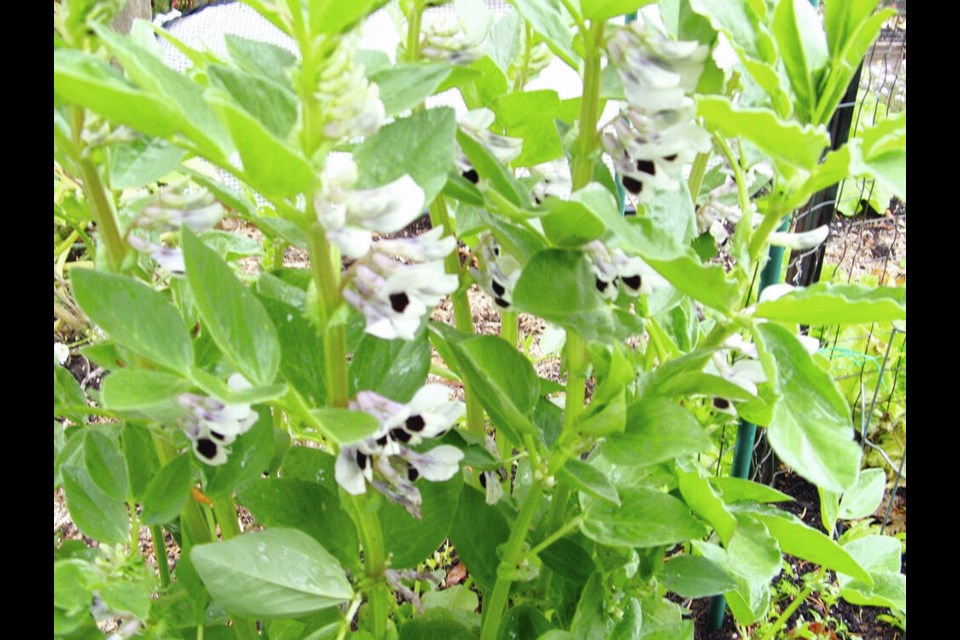By their leaves, the substantial cluster of sturdy seedlings looked like broad beans, as though someone had buried a hefty handful of the bean seeds beside a vegetable plot edge.
The puzzling, jammed-together plants grew to around 60 cm fairly quickly, and flowered to form a rather attractive display that has developed too late in the season for beans to form and mature.
Pea-shaped broad bean flowers, borne in showy clusters along the plant stalks, are white with striking black blotches. Their fragrance is a bonus. Variations in this ancient vegetable is a heritage variety known as crimson-flowered broad bean.
How this little surprise planting came to be is a mystery. I had buried kitchen vegetable and fruit trimmings into deep holes dug in the area, but I can’t imagine how viable broad bean seeds could have been among these on-site compostable materials.
Perhaps I’ll stumble upon an explanation at some point. Meanwhile, I’ll be enjoying the sturdy “bouquet” of broad bean plants until the flowers fade and frost kills them off.
Blooming giant. I almost always include some sort of marigold among the garden’s summer flowers. Their cheering splashes of orange brighten the landscape and, once planted, marigolds require no care apart from modest watering, In return, they deliver a long period of bloom.
This year I chose a dwarf (15-cm), mounding French marigold to edge a bed and provide spots of sunny colour in front of other annual flowers in the bed. The transplants developed into flower-filled little bushes that remained tidy and vibrant all summer and beyond — except for one of them.
From among the transplants I’d grown emerged one that bore the same deep orange, double flowers framed by rich mahogany outer petals, but in masses, on a 140-cm tall, multi-branched bush that became a showpiece in the summer and autumn garden until a heavy (52-mm) overnight rain last week bent the massive, top-heavy bush to the ground.
That surprise treasure of a plant triggered my addiction to alliteration into imagining various ways of describing the anomalous bush: Outstanding oddity? Wonderful weirdo? Fetching freak?
Was the giant marigold a throwback, a variation appearing out of the past exhibiting a trait of some ancestor of the marigold I chose to grow? Or was seed of a giant African marigold accidentally included in the package?
However the beautiful giant came to be, its presence has re-ignited an interest in growing tall African marigolds as well as dwarf French varieties in future gardens.
Stinky in Slovenia. From late August through September, my gardening friend Laurel and her husband Jeff trekked and toured through Slovenia. At a stay in one of the villages on their travels, Laurel spotted two women working in a small terraced plot. Curious about what they were doing, Laurel introduced herself.
The mother and daughter pair were pulling up their tomato plants. Why? Stink bugs. As in many of our gardens, stink bugs were something entirely new to the women this year. The bugs had pierced the fruits to feed, tainting them enough to render the tomatoes inedible. Laurel says that in the area she encountered uncomfortably dense numbers of stink bugs.
A parallel infestation of stink bugs so far away seems almost eerie — as in a world-wide stink bug invasion of gardens. Apparently the pest was introduced to Europe from China in the late 1990s and was first found in Slovenia in 2017.
My main stink bug infestation this year was in the raspberries. I eliminated many by picking them off the plants and dropping them into a bucket of soapy water. Because they drop off canes and stems easily when disturbed, I’m planning next year, at the first sign of the bugs, to shake the canes over the soapy water.
Having a pesticide-free, diverse garden ecosystem is helpful. Birds, bats and spiders eat stink bugs. The only one I found inside the house was caught in the web of a house spider.
GARDEN EVENT
Gordon Head meeting. The Gordon Head Garden Club will meet on Wednesday, Nov. 1, from 7 to 9 p.m. in the Gordon Head Lawn Bowling Club, 4105 Lambrick Way. Jayne Collier, manager of the Wild Birds Unlimited store, will speak about Winter Bird Feeding and rat proofing feeders. Visitors are welcome at no charge. The evening includes a parlour show and raffle.



